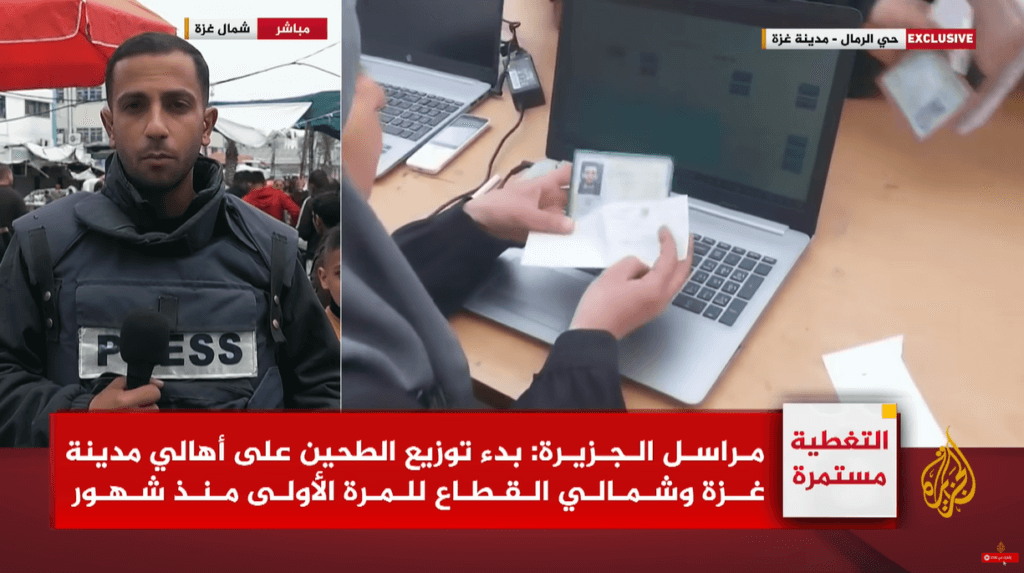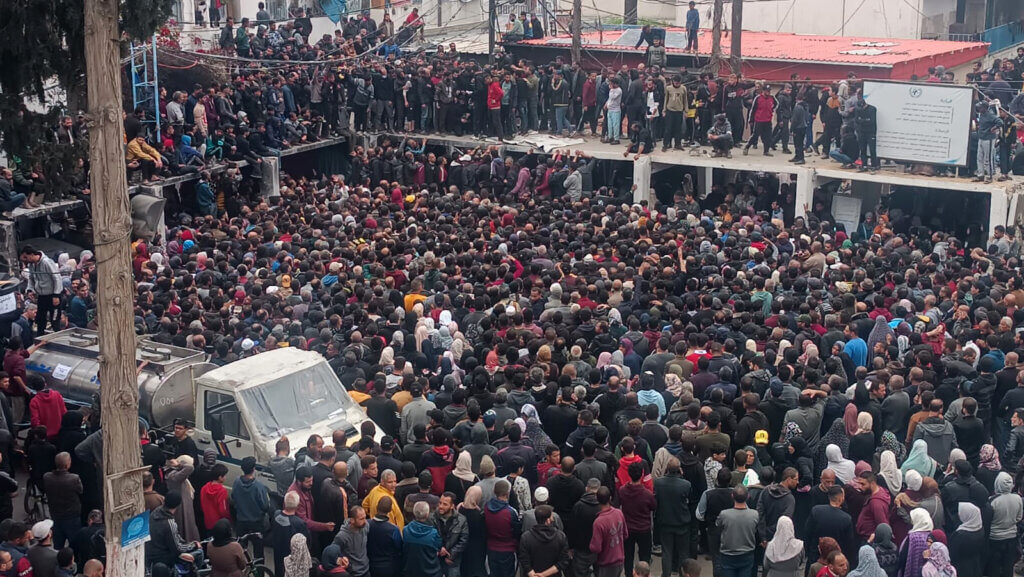The real reason Israel stormed al-Shifa Hospital yet again
Israel's latest attack on al-Shifa Hospital and the successful delivery of food aid to northern Gaza are connected. Here's how.
In the past two days, a number of things happened that seemingly had nothing to do with each other. At 2:00 a.m. on Monday, the Israeli army stormed al-Shifa hospital, entering with tanks and heavy gunfire and killing and injuring dozens. It was the fourth invasion of al-Shifa since October, resulting in the arrest of over 80 people.
The day before, 13 aid trucks arrived in northern Gaza for the first time in four months without being turned back by the Israeli army or resulting in the massacre of starving Palestinian aid-seekers. People flocking to the UNRWA warehouse in Jabalia refugee camp to receive the aid stood in uncharacteristically orderly lines and patiently waited for the handouts of flour, rice, and other foodstuffs. Many could be seen cheering once the aid arrived, a scene captured by Al Jazeera’s coverage.
But what few people know is that this successful delivery of sorely needed food aid to northern Gaza is what led the Israeli army to launch its deadly raid on al-Shifa Hospital the next day.
The connection between these two events can only be explained by understanding who Israel was targeting in the raid — the now-martyred Faiq Mabhouh.

Mabhouh was the Director of Operations of the Gaza police force, a part of the Gaza government’s civilian administration. Unlike Hamas’s military wing, the Qassam Brigades, Mabhouh did not operate clandestinely at the start of the war, because he didn’t have to — he was in charge of civil law enforcement. Hamas released a statement after his death confirming that he “engaged in purely civil and humanitarian activity.”
Yet to hear Israeli military spokespersons and the Israeli media, Israel had launched a “precise operation” on al-Shifa to target a “top Hamas operative,” or a “senior Hamas commander,” who the army alleged was planning attacks on Israel.
The attack on al-Shifa was an assassination operation aimed at breaking down civil order in northern Gaza to facilitate Israel’s genocidal project.
Making such brazen claims without evidence to justify attacking hospitals and shelters has been a hallmark of the Israeli army’s conduct throughout its genocidal assault. But the true significance of the attack lies not in its desire to empty northern Gaza’s largest civilian refuge, which houses 30,000 people, but in foiling Faiq Mabhouh’s pivotal role in coordinating the delivery of humanitarian aid to starving civilians in Gaza while restoring a semblance of social order to the north.
In other words, the attack on al-Shifa was an assassination operation aimed at breaking down civil order in northern Gaza. It aimed to facilitate Israel’s genocidal project and pave the way for total control over the area without resistance.
The unfolding events of the past few days expose Israel’s intentions of engineering famine and contributing to social breakdown. It reminds us that this is not only a war against Gaza’s resistance but also against its people.
Delivering aid while avoiding another ‘flour massacre’
On March 17, images of pamphlets circulated on social media bearing the signature of the “Palestinian Security Forces” addressed to all civilians in northern Gaza. In order to “ensure the secure arrival of aid” in the north, the notice barred all people from gathering at the Kuwaiti roundabout and Salah al-Din Street, the main entry points through which humanitarian aid reaches the north. In most previous attempts, throngs of starving people gathered at those locations and rushed aid trucks as they arrived.
Israeli forces fired on the crowds many times, killing hundreds of people, most infamously during the “Flour Massacre” on March 3. On occasions where Israel did not mow down the desperate crowds, it stopped aid trucks and turned most of them back, citing spurious “dual use” claims.
Yet what is most remarkable about the circulation of this notice is that the starving people of northern Gaza complied. The aid convoy arrived in Jabalia refugee camp at a UNRWA facility shortly after midnight on March 17, unmolested and to much popular fanfare.

The convoy was accompanied by an escort of masked gunmen whose identities were unknown. Much speculation as to who they were abounded, with Al Jazeera correspondent Ismail al-Ghoul commenting that the aid convoy was coordinated by Gaza’s clans. Later on that same day, as the aid was being distributed, Al Jazeera reporter Anas al-Sharif said that the convoy was organized by “local committees and monitoring committees comprised of clans, notables, and elders, who oversaw the arrival of the aid.”
Yet that same broadcast showed images of those processing the handouts, who used laptops to register aid recipients with their ID cards and entered them into a registry. These were the tell-tale signs of the bureaucracy of Gaza’s civil government.

Al Jazeera’s footage also depicted long, orderly lines of people receiving aid, in sharp contrast with the chaotic and bloody scenes that had predominated in previous incidents at the Kuwait roundabout and Salah al-Din Street. The scene was clear in its implication: attempts were being made to restore civil order in northern Gaza and to improve the lot of the suffering population.
Not 24 hours later, in the predawn hours of March 18, Israel invaded al-Shifa. The news emerged that the army had assassinated Faiq Mabhouh, and that an Israeli soldier had been killed after Mabhouh reportedly refused to surrender. Suddenly all news sources were saying the same thing: Mabhouh had been behind the effort to coordinate the arrival of the aid.
Mabhouh’s role
The information available on Mabhouh’s duties remains scant, often blending fact with speculation regarding his activities and the reason for his assassination. Most media sources agree that Mabhouh organized the delivery of the aid convoy, which he did in coordination with Gaza clans, UNRWA, and international organizations.
Crucially, that coordination entailed meeting with officials from those groups. One of the widespread pieces of speculation holds that it was at those meetings that Mabhouh’s location was exposed and supposedly leaked to Israel’s intelligence, likely through one of those international organizations. Haaretz speculates that this intelligence leak “may explain Israel’s urgency to launch an immediate operation at the hospital.”
Being the head of a civilian police force, Mabhouh operated publicly earlier on in the war, but as Israel continued to target members of the local police, the need for secrecy became more apparent. According to Axios, the Biden administration asked Israel back in February to “stop targeting members of the Hamas-run civilian police force who escort aid trucks in Gaza, warning that a ‘total breakdown of law and order’ is significantly exacerbating the humanitarian crisis.”
Israel never stopped targeting them and indeed went above and beyond in massacring hundreds of civilians seeking food. This context explains why the police force apparently switched to operating clandestinely and why the gunmen accompanying the convoy were masked. It also explains why the public narrative around the distribution of the aid was that it was organized by the clans.
But mention of the clans is not incidental here. One of the most important aspects of Israel’s supposed “day after” scenario for Gaza is that day-to-day activities would be managed by local families and tribes. Gaza’s traditional clans used to hold greater sway in the coastal enclave prior to Hamas’s ascendancy to power in 2007, some of them acting as lawless gangs that engaged in criminal activity. Hamas severely curtailed their role during its period of rule over the Strip, but during the latest genocidal war, many of these families took advantage of the chaos to commandeer aid convoys and hoard food aid or sell it on the black market.
Israel has not only welcomed the development but actively encouraged the state of lawlessness. Its continued targeting of Gaza police escorts only reinforced the phenomenon. At around the same time, Israeli officials began to float the idea of postwar tribal rule in Gaza.

This relates to the second part of the speculation surrounding Mabhouh’s assassination — that he was involved in cracking down on clans that seized food aid, likely to be the same clans who would be contenders in Israel’s vision of postwar rule in Gaza.
One unsubstantiated rumor was widely circulated on social media in Arabic and picked up by the Israeli media: Hamas had supposedly executed the unnamed head of the influential Doghmosh clan in Gaza for allegedly stealing humanitarian aid and being suspected of collaborating with Israel. The Doghmosh clan put out a statement strongly denying the claim, asserting that the clan chief had been martyred during an Israeli airstrike on November 16, 2023. An investigation conducted by Al Jazeera revealed that the name of the family’s head (the mukhtar) was on the list of the dead from that airstrike.
Regardless of the veracity of the speculation, what has become clear is that Israel’s genocidal war has taken on a new dimension — it is encouraging societal collapse in Gaza. Its engineering of famine and the enablement of lawlessness is simply a continuation of its military campaign through other means. And when members of the civilian government attempt to ameliorate the famine or try to work to restore social order, Israel launches a war against them, too.
Thanks to Jehad Abusalim for contributing crucial insights to this report.
https://mondoweiss.net/2024/03/the-real-reason-israel-stormed-al-shifa-hospital-yet-again/
posted by Satish Sharma at
04:40
![]()


0 Comments:
Post a Comment
Subscribe to Post Comments [Atom]
<< Home